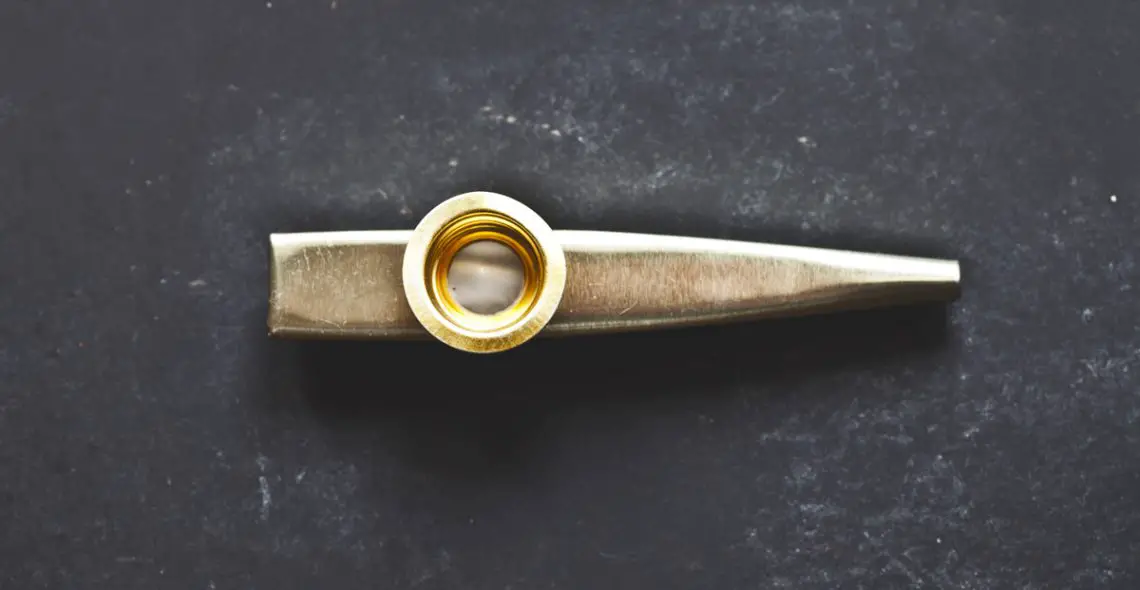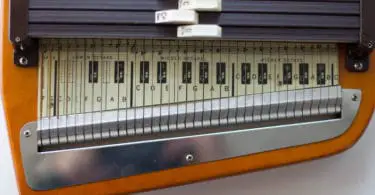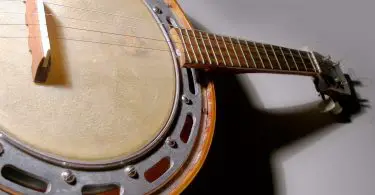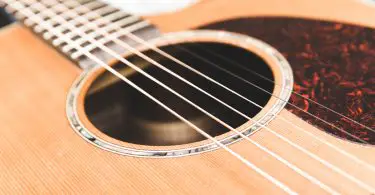When you consider genre-spanning instruments, kazoos are a whimsical, easy-to-learn addition to any musician’s collection. Don’t let their ubiquitousness fool you. Some kazoos are better than others. To help you choose, here is a list of the top kazoos you can find on the market today.
It took hundreds of reviews of kazoos on the market, as well as extensive research into the hearts and minds of kazooists on YouTube and in forums around the world to complete this list. Whether you’re an amateur kazooist or looking to sharpen your kazoo IQ, here is your one-shop stop for all of the important kazoo information you’ll need to decide what kazoo is best for you.
The type of kazoo you choose will affect the acoustic quality of the sound and the longevity of your instrument. Kazoos come in plastic, metal, wooden and even electric, so it ultimately comes down to your personal style and sound quality.
Available in both silver and gold, this is the most durable, lightweight metal kazoo you can find. The notes blend smoothly, encouraging musicians of all ages and experience levels to keep on kazooing.
How to Play the Kazoo
Kazoos are one of the most deceptively simple instruments to pick up and play. This is because there are no notes to learn and no holes or slides to configure. You only use your voice. But, like most instruments, you still need a sense of timing, rhythm, and melody.
Basically, you need to be a good singer to be a good kazooist. If you can’t carry a tune, a kazoo isn’t going to be forgiving. You don’t just blow into a kazoo. Playing the kazoo is more like humming or making other sounds with your voice. There is no sheet music you need with a kazoo.
The kazoo is perhaps the instrument that is the closest thing to your vocal chords. You create the pitch of the kazoo pitch with your voice. The quality of your kazooing is directly proportional to the quality of your singing. Your voice makes the sound, and the kazoo transforms it into music. Keep reading to learn lots more about kazoos, as well as the top kazoos today.
-
-
 $6.99Check on Amazon
$6.99Check on AmazonAvailable in both silver and gold, this is the most durable, lightweight metal kazoo you can find. The notes blend smoothly, encouraging musicians of all ages and experience levels to keep on kazooing.
06/29/2025 01:21 am GMT -
 $15.99Check on Amazon Check on eBay
$15.99Check on Amazon Check on eBayFor loud and playful performances with a goofy presentation.
06/29/2025 12:15 am GMT -
 $23.95Check on Amazon Check on eBay
$23.95Check on Amazon Check on eBayFor electronic or metal bands who want to experiment with a new sound.
06/28/2025 11:17 pm GMT
Why Your Kazoo Needs a Membrane
Most kazoos have a submarine-like body with a wide opening on one end tapering toward a narrow opening on the other end. They also have a resonator protruding from the top. However, a kazoo wouldn’t be a kazoo without the membrane. The top kazoos have membranes that stay in place without slipping.
That’s the part of the resonator that earns its name. The membrane is a small piece of plastic or wax paper that resonates your voice into kazooing vibrations. The number one key to kazoo maintenance is to keep your kazoo stocked with an intact membrane.
Your local music shop likely sells membrane replacements, but in a pinch, you can cut a plastic bag or wax paper into the appropriate size for your kazoo resonator. If your membrane is damaged or falls out of the resonator easily, your kazoo won’t work properly, or even at all.
Types of Kazoos for Today
There’s no need to spend an excessive amount of money on a kazoo: You can find most quality kazoos for under $10, typically as low as the $2 to $7 range. Before you decide how much you’re willing to invest and which type of kazoo you want, ask yourself this:
- What are your kazooing purposes?
- Are you casually curious about adding a new instrument to your repertoire?
- Are you purchasing a kazoo for a child?
- Are you in a band looking for a new sound to spice things up, and, if so, what type of music?
In jug bands and video game cover songs, the kazoo is a natural fit. In metal bands and electronic music, the kazoo can add a fascinating new layer to your band’s sound.
Once you’ve answered these questions, the most important factor to consider is the type of material from which they craft the kazoo. The most common types of kazoo materials are plastic or metal, but you can also find wooden kazoos available. Here is an overview of the materials you will find in the top kazoos.
Plastic Kazoos: Colorful and Whimsical, Too
Plastic kazoos are the classic kazoo everyone thinks of when they picture a kazoo. If you’re looking for product recognition and whimsical styles in a variety of bright colors, plastic kazoos are for you. These are a solid choice for kids, jug bands, goofy song covers and musicians who don’t take themselves too seriously.
After all, how serious can you be when you’re trilling away on an orange and yellow kazoo? Plastic kazoos are a top choice for multi-tasking musicians. So if you need both hands for your guitar or keyboard, the plastic kazoo is easy to grip between your teeth to play simultaneously.
The main downside of plastic kazoos is the tendency to break the notes a little. When you switch between notes, the kazoo canal can be a little fuzzy on note clarity. It’s a tone that is distinctively kazoo, but not the most pleasant sound when you want your audience to want to listen.
Musicians who are experimenting with the top kazoos would be wise to consider owning a plastic and a metal kazoo. If you’re playing around in a broad harmonic range, plastic will have your back on the lower tones, while metal can handle the rest.
Metal Kazoos: A Musician’s Secret Weapon
As demonstrated by the first pick of the top kazoos, metal kazoos are a serious musician’s secret weapon. Manufacturers make metal kazoos with various metal alloys, but they can sound as rich and bold as brass. It’ll take some practice and skill, but it’s not out of the realm of possibility that your metal kazoo could resemble a trumpet if listeners close their eyes.
The metal holds the notes clearly, which helps you transition between smoother pitches, lending itself well to jazz, as well as metal or electronica. Metal kazoos can handle lead melodies and harmonies more seamlessly than plastic kazoos. Also, their wider range of pitch control makes them a more versatile instrument.
The main downside to a metal kazoo is, if you’re a multi-tasker, it’s not as easy to grip a metal kazoo between your teeth. You’ll need at least one hand to hold it. Another downside is some metal kazoos have a weird taste because of the type of metal. But the celebrated musical quality benefits outweigh the narrow possibility you won’t like the taste of the kazoo metal
Wood Kazoos: A Handcrafted Instrument
Wood has a more open sound that some folksier musicians like. Some independent artists and musicians often handcraft wooden kazoos, so your kazoo is a work of art, as well as an instrument. The time it takes to craft them means wooden kazoos come at steeper prices in the $20 to $40 range.
The type of wood, the atmosphere of the workshop, and the type of wood finishing product they use all affect the taste of a wooden kazoo. You could spend a good chunk of coin on a kazoo you don’t want to put to your lips. And that is why the wooden kazoo is not one of the top kazoos you can buy today.
A Modern Marvel: Electric Kazoos
Whether you choose a plastic or metal kazoo, you have the option of enhancing or manipulating the sound by turning it into an electric kazoo. Essentially, electric kazoos are regular kazoos with a pickup to plug into an amplifier or a guitar effects pedal. They give you more freedom to play around with your kazoo music, which is especially creative it if you’re in a rock or electronic band.
The pickup goes into the kazoo’s resonator, so you should use the kazoo that comes in the electric kazoo set for the proper fit. Like wooden kazoos, electric kazoos will cost you a fair bit more than your average kazoo. But that’s still pennies compared to most musical instruments for one of today’s top kazoos. You can find most electric kazoos in the $20 range.
The Competition
After hours of testing and research, here’s the final competition.
Our Top Pick: OIBTECH Metal Kazoo
If you want a kazoo that will have you buzzing away for years to come, your best bet is an OIBTECH Metal Kazoo. The OIBTECH Metal Kazoo is the king on this list of the top kazoos. For those who prefer a metal kazoo over other types of kazoos, OIBTECH crafts the most durable, lightweight metal kazoo you can find. The notes blend smoothly, encouraging musicians of all ages and experience levels to keep on kazooing.
The greatest thing about metal kazoos like the OIBTECH is they still sound like a kazoo minus the obnoxious buzzing of plastic kazoos. The tones are smoother and more like the imitation of a brass band. The sound is not quite like a saxophone or trumpet, but quite similar.
Available in both silver and gold, this is the most durable, lightweight metal kazoo you can find. The notes blend smoothly, encouraging musicians of all ages and experience levels to keep on kazooing.
You can reach more solemn tones with a metal OIBTECH, more suited to the character of a metal band. If you’re looking for a brighter, buzzy sound, check out the plastic runner-up. But if you want to redefine for your sound and show your listeners what a kazoo can do, pick up an OIBTECH Metal Kazoo.
Unlike some metal kazoos, the OIBTECH does not have any sharp edges, so you won’t have to worry about an injured lip while you’re deep in song. By most accounts so far, the metal alloy is resilient and won’t deteriorate with too much use. The cap of the resonator is screwed in securely, yet it’s easy to unscrew if you need to replace the membrane.
Clocking in around $7 per kazoo, the OIBTECH Metal Kazoo is a solid choice for any kazoo enthusiast. Whether you’re an amateur or a seasoned pro who’s looking for a kazoo that can keep up with the evolution of your craft, this one’s for you.
Our Runner-Up: Wazoo
The runner-up pick on this list of the top kazoos on the market is the Wazoo, which is a loud kazoo with the attachment of a horn. At around $6, when you need a kazoo that must be louder than the rest, reach for a Wazoo. It’s a kazoo with a horn branching off the top to amplify the sound. Adding the horn to the kazoo creates a richer, slightly different tone, in addition to making it louder. It’s also neat to be able to hinge your palm on the horn as a mute.
For loud and playful performances with a goofy presentation.
The Wazoo’s horn is removable, which makes it a versatile choice. Many musicians prefer the wazoo because it blares the classic plastic kazoo sound with double the amplification of a normal kazoo. That makes for loud and playful performances with a unique presentation.
When you need to practice or mess around in a less flashy way, you can remove the horn. Wazoo colors vary, but the kazoo body and the horn tend to be mismatched bright colors.
Other Kazoos to Consider:
Kazoobie HUMMbucker Electric Kazoo

Credit: Amazon.com
Here a couple of Kazoobie top kazoos worth your consideration. First, the Kazoobie HUMMbucker Electric Kazoo is the choice for a harder sound. It’s a little pricier than the average kazoo but it includes both a kazoo and the pickup that makes it electric.
For electronic or metal bands who want to experiment with a new sound.
The trusted brand, Kazoobie, crafts it, so the HUMMbucker takes a classic plastic kazoo and turns it up to eleven by letting you plug into an amplifier. When you pair it with a professional grade pickup using a 15-foot cable and quarter-inch plug, this kazoo set gives you more freedom in the sounds you can make with a kazoo.
This kazoo is for electronic or metal bands who want to experiment with a new sound. Typically, performers amplify a kazoo by playing it directly into a microphone. By plugging your kazoo into an amp or guitar effects pedal, you get volume and can distort and manipulate kazooing to your heart’s desire.
Kazoobie Plastic Kazoos

Credit: Amazon.com
Kazoobie Plastic Kazoos are the second Kazoobie pick when you need an easy-to-use, affordable kazoo. They typically cost around $13 for a set of eight kazoos. If you only need kazoos for a single event, like a one-off concert or a kid’s birthday party, Kazoobie Plastic Kazoos can deliver without much fuss but still sound good. Although they don’t cost much, they craft Kazoobie Kazoos with resilient membranes and tightly packed caps.
For when you need a lot of easy-to-use kazoos, poor resonance, and cheap membranes.
Some musicians swear by Hohner as the best for plastic kazoos, but when you compare them to Kazoobie, Hohners have poor resonance and membranes that fall out easily. If you’re looking for a basic plastic kazoo or even a whole set of them for a kazoo orchestra, Kazoobie belongs on this list of the top kazoos available today.
In Summary
Have you found your favorite on this list of top kazoos? Perhaps it was an electric kazoo or even a wooden one. Whatever you choose, you will have a unique and whimsical instrument you can play anywhere and anytime.












Start the discussion at talk.hearthemusicplay.com